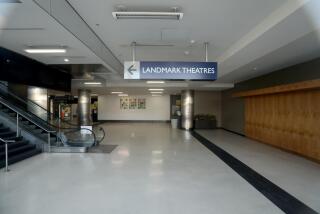Light Brigade
- Share via
Engineering students at UCLA knew how to get their start in show business.
They reached for the stars. And then they repaired them.
In exchange for rebuilding the university’s broken star projector and returning it to use as a teaching tool for the first time in years, the fledgling engineers have won permission to use UCLA’s dome-roofed planetarium for do-it-yourself laser shows.
Their tinkering with the huge, insect-shaped projector that casts tiny light spots on the dome’s ceiling saved the university $500,000. That’s the amount officials figure a new one would have cost.
“Even the company that sold us the projector couldn’t fix it. They sent their own crew out and couldn’t do it,” said Laurie Liles, program administrator for UCLA’s astronomy and astrophysics department.
“Then Mark Ross came in, wanting to use the planetarium for laser shows,” she said.
Ross, a 29-year-old graduate electrical engineering student from Van Nuys, didn’t know what to make of the projector when he first looked at it. What he was really looking at, of course, was the 24-foot-high dome that arches over it.
*
Also 24 feet in diameter, the circular planetarium seats 50. It has been perched on the roof of the campus Math-Science Building for 40 years.
Ross was searching for a place where fellow engineering students could stage laser shows--colorful displays of pulsating, pinpoint lights that can be programmed by computer to dance to music or simulate cartoon drawings when shown on a wall or ceiling.
Laser shows are nothing new. They have been produced at Griffith Observatory’s planetarium since 1973.
At UCLA, engineering students have played around with lasers and music since 1980, when the first of a series of light shows was presented as part of the school’s annual Mardi Gras student fund-raising fair.
Through the 1980s, budding engineers staged 15-minute Mardi Gras shows on a bedsheet suspended in a tent on the campus’ intramural athletic field, charging admission to help send poor children to summer camp.
After nighttime Mardi Gras operations were canceled for security reasons in 1993, students in Tau Beta Pi, the school’s engineering honor society, hunted for another place for the shows that they called “Laserama.”
The planetarium was Ross’ idea. He figured the engineers-to-be could incorporate stars and galaxies in their light show if they could get permission to use the dome.
It would be OK to use the room, astronomy officials told the students. But keep your hands off the old projector, they warned. It doesn’t work. Plus, it is dangerous.
*
Sure enough, sparks flew and smoke poured out when Ross and his friends furtively switched the projector on during their first day there. Wires inside were loose and bulbs were blown out, leaving large sections of the starry sky blacked out.
“You couldn’t see the moon or huge chunks of stars. Some of the planets were missing. Other planets were in the wrong location,” Ross said.
Engineering students managed to get a few stars shining on the ceiling, however. More spectacular was the sound system they built for their music shows. Astronomy department administrators were impressed when they poked their heads inside the dome to see how things were going.
“They said, ‘Hey, how about fixing the projector?’ ” Ross said. “I said we’d see what we could do.”
It took several hundred hours of work before the students had pried loose lightbulbs they found melted into their sockets and replaced blown fuses, broken wiring and missing lenses. Soon, stars were once more shining over UCLA.
These days the planetarium is again being used by astronomy students, and weekly star shows are staged there for the public, by both the astronomy and the engineering students.
Astronomy students say they don’t mind that the planetarium is used for light and music productions. They’re just pleased that the projector works.
“We needed it fixed, and we didn’t have money to do it,” said Varoujan Gorjian, 28, an astronomy graduate student. “They do a good job with the star shows, even if they are engineering students. We don’t worry they’re moving in on our turf. This has become an incredibly good marriage.”
*
The laser shows are the engineering students’ pride and joy, however. They have designed and programmed four different hourlong productions with themes based on cartoons, magic, animals and rock ‘n’ roll.
They are variously staged Tuesday and Wednesday evenings and Sunday afternoons. Tickets are $5 for adults, $3 for children.
About 60 engineering students worked to repair the projector and write computer programs that run the shows’ three lasers. They get no class credit for their efforts.
Still, as graduate electrical engineering student Albert Nelson, 24, put it: “I’ve never really considered myself a creator of entertainment. But people in the audience are pretty impressed.”
Eight-year-old Jonathan Sauer was.
“It was really good. It’s cool that students did it,” said Jonathan, a Westwood third-grader who took in a recent show with his family.
Vital Vayness, a Westside marketing consultant who was also at the show with his family, agreed. “The kids liked the music and characters. I thought its length was just right.”
There was only one problem with the planetarium’s eighth-story rooftop site: “It was a lot of work to get there--the elevator wasn’t working,” Vayness said.
Sounds like another project for engineering students.
More to Read
Sign up for Essential California
The most important California stories and recommendations in your inbox every morning.
You may occasionally receive promotional content from the Los Angeles Times.











